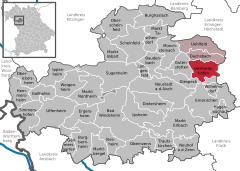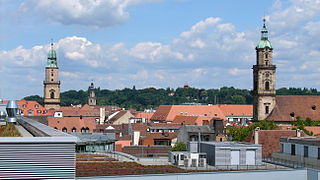
Erlangen is a Middle Franconian city in Bavaria, Germany. It is the seat of the administrative district Erlangen-Höchstadt, and with 119,810 inhabitants, it is the smallest of the eight major cities in Bavaria. The number of inhabitants exceeded the threshold of 100,000 in 1974, making Erlangen a major city according to the statistical definition officially used in Germany.
Erlangen-Höchstadt is a Landkreis (district) in Bavaria, Germany. It is bounded by the districts of Fürth, Neustadt (Aisch)-Bad Windsheim, Bamberg, Forchheim and Nürnberger Land, and by the cities of Nuremberg and Erlangen. The city of Erlangen is not part of the district, but nonetheless its administrative seat.
Neustadt (Aisch)-Bad Windsheim is a Landkreis (district) in Bavaria, Germany. It is bounded by the districts of Würzburg, Kitzingen, Bamberg, Erlangen-Höchstadt, Fürth and Ansbach, and by the state of Baden-Württemberg.

Etzenricht is a municipality in the Upper Palatinate, ca. 6 km (3.7 mi) southeast of Weiden in the district of Neustadt an der Waldnaab in Bavaria in Germany.

Neustadt an der Aisch is a small town of around 13,000 inhabitants in the northern part of Bavaria (Germany), within the Franconian administrative region Middle Franconia. It is the district town of the district Neustadt (Aisch)-Bad Windsheim.

Vilseck is a town and municipality in the Oberpfalz region of northeastern Bavaria, Germany, situated on the river Vils, a tributary of the Naab river. As of December 31, 2022, Vilseck's population was 6,768 citizens, who live within an area of 64.71 km2 (24.98 sq mi) consisting of Vilseck town proper and 35 other hamlets and villages. The town is 402 meters above sea level.

Stein is a town in the district of Fürth, in Bavaria, Germany. It is situated 7 km south of Fürth, and 7 km southwest of Nuremberg (centre).

Ergersheim is a municipality in Bavaria, Germany.

Breitengüßbach is a community in the Upper Franconian district of Bamberg in Bavaria. It was first mentioned as Gusibach and as belonging to the royal court at Hallstadt in an Imperial document issued between 812 and 830.

Heroldsberg is a municipality in the district of Erlangen-Höchstadt, in Bavaria, Germany. It is located eleven kilometers north-east from the city of Nuremberg and 23 kilometers east from Erlangen and is the headquarters of Schwan-Stabilo.
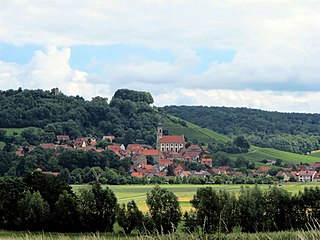
Castell is a municipality in the district of Kitzingen in Bavaria in Germany. It was the seat of the Counts of Castell. Today it is part of the municipal association Wiesentheid. It has around 800 inhabitants.

Neustadt am Main is a community in the Main-Spessart district in the Regierungsbezirk of Lower Franconia (Unterfranken) in Bavaria, Germany and a member of the Verwaltungsgemeinschaft Lohr am Main.

Lupburg is a municipality in the district of Neumarkt in Bavaria in Germany.

Dachsbach is a market town and municipality in the district of Neustadt (Aisch)-Bad Windsheim, in the administrative region of Middle Franconia in northern Bavaria in Germany.

Illesheim, founded 1283 AD, is a municipality in the district of Neustadt (Aisch)-Bad Windsheim in Bavaria in Germany. The earliest leader affiliated with Illesheim's foundation was Götz von Berlichingen, known as "the Knight with the Iron Hand." Also known locally as "Illesa". It lies 6 kilometers west of Bad Windsheim and 11 kilometers east of the A7 motorway.

Sugenheim is a municipality in the district of Neustadt (Aisch)-Bad Windsheim in Bavaria, Germany. The municipality consists of eleven villages:

Uehlfeld is a municipality in the district of Neustadt (Aisch)-Bad Windsheim in the administrative region of Middle Franconia in northern Bavaria in Germany.
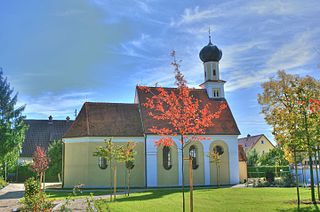
Asbach-Bäumenheim is a municipality in the district of Donau-Ries in Bavaria in Germany.

Wilhelmsdorf is a village in the district of Neustadt (Aisch)-Bad Windsheim in Bavaria in Germany.
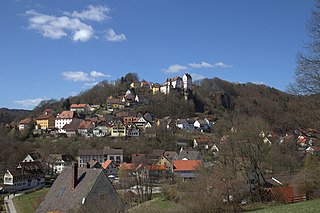
Egloffstein Castle is a former high mediaeval, aristocratic castle, that stands immediately west of the eponymous village of Egloffstein in the Upper Franconian county of Forchheim in the German state of Bavaria.
